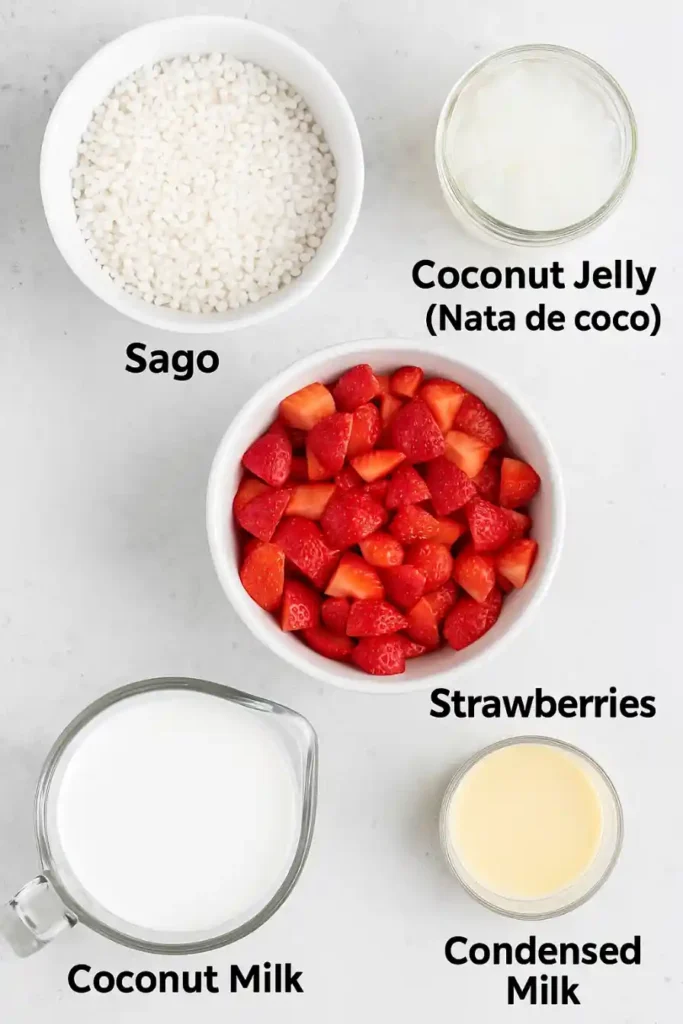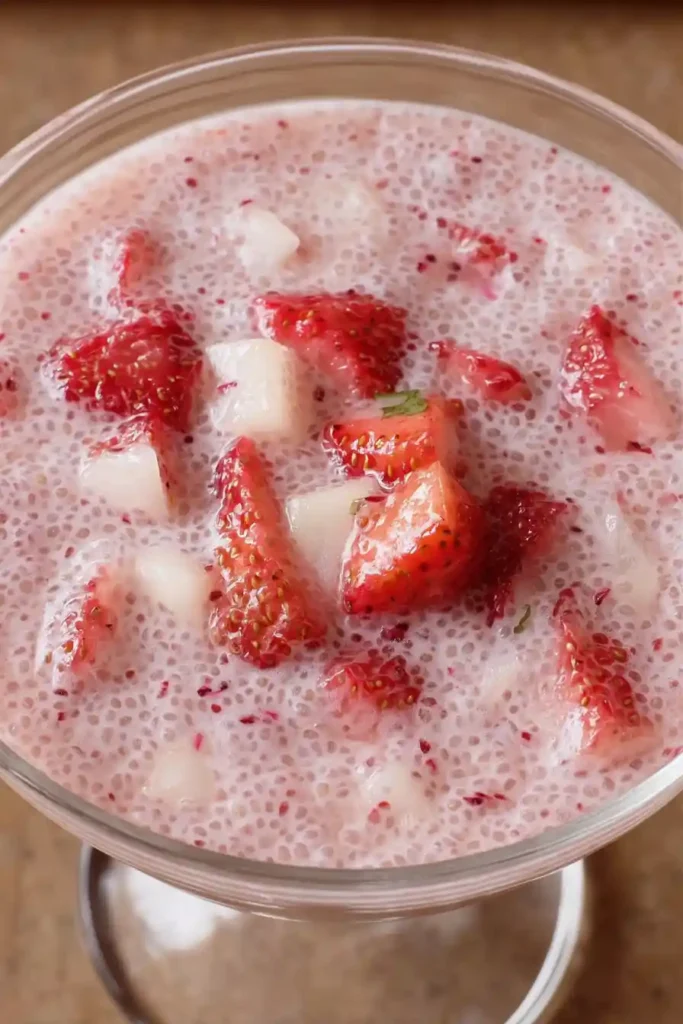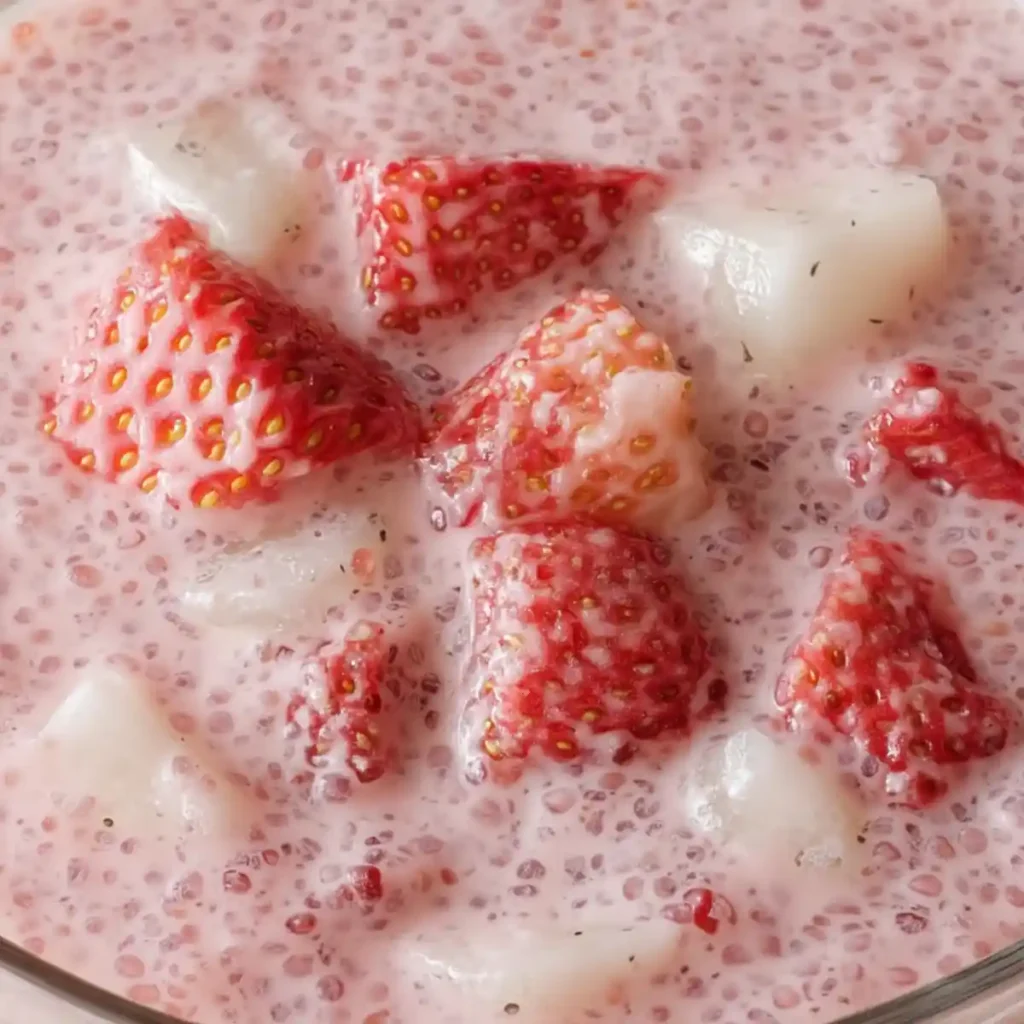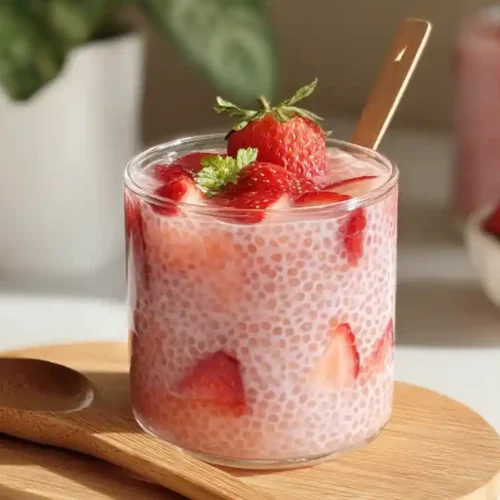Creamy, sweet, and laced with chewy pearls, Strawberry Sago is a chilled dessert made with tapioca pearls, ripe strawberries, and coconut milk. It’s a popular summertime treat in many Asian households, known for its satisfying texture and fresh fruit flavor. This version stands out for its ease, minimal ingredients, and a smooth, fruity finish that comes together with little effort. You don’t need fancy tools or complicated steps—just a handful of ingredients and some fridge time.
Why You’ll Love This Recipe
- Quick and Simple: Minimal prep. No baking. Just cook the pearls and mix.
- Short Ingredient List: Only six main ingredients—most are pantry staples.
- Perfect for Summer: Serve it cold for a refreshing finish to any meal.
- Family-Friendly: Kids love the chewy pearls and sweet strawberry flavor.
- Customizable: Use dairy or non-dairy milk. Add other fruits or jellies.
- Textural Bliss: Creamy coconut milk, chewy sago, juicy strawberries, and slippery jelly in every bite.
Unlike overly sweet versions, this recipe lets the strawberries shine. The secret? Letting everything chill overnight to deepen the flavors.
Ingredients Needed

For the Base:
- 1–2 lbs (450–900 g) fresh strawberries, hulled and chopped
- 1/2 cup (100 g) small white sago (tapioca pearls)
- 6 cups (1.5 L) water – for boiling sago
For the Creamy Mixture:
- 1 pack (8–12 oz / ~250–350 g) coconut jelly (nata de coco), drained
- 2 cups (480 ml) coconut milk, half & half, or heavy cream – adjust based on richness preference
- 1/2 cup (120 ml) sweetened condensed milk – adjust to taste
Ingredient Notes
- Strawberries: Use ripe, red strawberries that smell sweet. Underripe ones taste bland.
- Sago: Look for small white tapioca pearls. These are not the same as boba (black tapioca pearls for drinks).
- Coconut Jelly (Nata de Coco): Adds a fun, chewy texture. Find it in Asian grocery stores, usually in jars or pouches.
- Coconut Milk: Full-fat gives the best texture. Light versions work but will be thinner.
- Condensed Milk: Sweetens and thickens. Taste before adding more.
Substitution Ideas
- Strawberries: Frozen strawberries work. Thaw them in the fridge overnight or microwave briefly. Drain excess liquid before using.
- Sago: You can’t replace this with boba or chia seeds. The texture and cook time are different.
- Coconut Milk: Use oat milk or almond milk for a lighter, dairy-free version.
- Condensed Milk: Use condensed coconut milk for a dairy-free twist. For less sweetness, add a little maple syrup or agave instead.
How to Make Strawberry Sago

1. Cook the Sago Pearls
- Rinse the sago under cold water to remove surface starch.
- Bring 6 cups of water to a boil in a large pot. Add the sago pearls.
- Reduce heat to medium and simmer for 10–12 minutes, stirring occasionally to prevent sticking.
- When the pearls are mostly translucent with a tiny white dot in the center, remove from heat.
- Cover with a lid and let them sit for 10 more minutes to finish cooking.
2. Drain and Rinse
- Pour the sago into a strainer and rinse thoroughly under cold water to stop cooking and remove extra starch.
- Drain well and set aside.
3. Prepare the Strawberries
- Wash, hull, and dice the strawberries.
- Reserve a handful for garnish if desired.
4. Combine Ingredients
- In a large bowl, mix the drained sago pearls, chopped strawberries, and coconut jelly.
- Pour in the coconut milk and condensed milk. Stir gently to combine.
5. Chill
- Cover and refrigerate for at least 4 hours, ideally overnight. This allows the flavors to blend and the sago to absorb the liquid.
6. Serve
- Stir before serving. Spoon into bowls or glasses.
- Optional: Add crushed ice for an extra refreshing touch.
Expert Tips for Success
Perfect Sago Texture
- Don’t overcook: Stop when the pearls still have a small white center—they’ll finish in residual heat.
- Rinse well: This removes extra starch, preventing a gummy texture.
Flavor Boosting Secrets
- Macerate strawberries with a teaspoon of sugar before mixing for extra juiciness.
- Add a splash of vanilla extract or lime zest for a twist.
Avoid Common Mistakes
- Don’t skip rinsing the cooked sago—it will clump.
- Don’t use too much condensed milk without tasting. It can overpower the fruit.
Ingredient Prep Tips
- Dice strawberries small so they mix evenly and don’t sink.
- Drain nata de coco completely to avoid watery pudding.
Serving and Storage Tips

- Serving: Serve in chilled glasses or dessert bowls. Garnish with strawberry slices or mint.
- Storage: Keep in an airtight container in the fridge for up to 4 days.
- Not Freezer-Friendly: Tapioca turns hard and unpleasant after freezing.
Helpful Notes
- Want a smoothie bowl version? Blend some of the strawberries with the milk before combining.
- Adjust the thickness by using more or less coconut milk.
- Leftovers are great the next day—flavors deepen over time.
Nutritional Information (Per Serving)
| Nutrient | Amount |
| Calories | 444 kcal |
| Carbohydrates | 47 g |
| Protein | 6 g |
| Fat | 28 g |
| Saturated Fat | 23 g |
| Polyunsaturated Fat | 1 g |
| Monounsaturated Fat | 2 g |
| Cholesterol | 13 mg |
| Sodium | 108 mg |
| Potassium | 564 mg |
| Fiber | 3 g |
| Sugar | 26 g |
| Vitamin A | 116 IU |
| Vitamin C | 70 mg |
| Calcium | 158 mg |
| Iron | 4 mg |
Conclusion
Strawberry Sago is easy, comforting, and refreshing. The creamy base, juicy fruit, and chewy textures come together in a dessert that’s both light and satisfying. It’s a crowd-pleaser that works for parties, family dinners, or even a quiet night in.
Tried this recipe? Leave a comment and star rating below! Share your results on Pinterest or Facebook—we’d love to see your version.
What’s your favorite twist on this recipe? Did you add other fruits or toppings? Let us know below!
________________________

Strawberry Sago
Ingredients
Base Ingredients
- 1.5 lbs fresh strawberries hulled and chopped
- 0.5 cup small white sago (tapioca pearls)
- 6 cups water for boiling sago
Creamy Mixture
- 300 g coconut jelly (nata de coco) drained
- 2 cups coconut milk or half & half/heavy cream
- 0.5 cup sweetened condensed milk adjust to taste
Instructions
- Rinse the sago under cold water to remove surface starch. Bring 6 cups of water to a boil. Add sago and simmer for 10–12 minutes. Cover and let sit for 10 minutes off heat.
- Drain sago and rinse under cold water thoroughly. Set aside.
- Wash, hull, and chop the strawberries. Reserve a handful for garnish if desired.
- In a large bowl, mix sago pearls, strawberries, and drained coconut jelly.
- Add coconut milk and sweetened condensed milk. Stir gently to combine.
- Cover and refrigerate for at least 4 hours or overnight. Stir before serving. Garnish with strawberries or mint if desired.
Video
Notes
- Serving Size: 1g
- Calories: 444 kcal
- Carbohydrates: 47 g
- Protein: 6 g
- Fat: 28 g
- Saturated Fat: 23 g
- Polyunsaturated Fat: 1 g
- Monounsaturated Fat: 2 g
- Cholesterol: 13 mg
- Sodium: 108 mg
- Potassium: 564 mg
- Fiber: 3 g
- Sugar: 26 g
- Vitamin A: 116 IU
- Vitamin C: 70 mg
- Calcium: 158 mg
- Iron: 4 mg
Nutrition
Explore More Delicious Recipes
If you enjoyed diving into the Strawberry Sago, why not explore more delightful dishes from our collection? Here are some must-try recipes to elevate your cooking adventures:
- Brookie Recipe: Irresistibly Perfect Treat You’ll Crave
- Moose Farts Recipe: Ultimate Easy Treats Guide
- Delicious Crack Cake Recipe For A Moist Treat
- Delicious No Bake Cherry Cheesecake Recipe
- Delicious Cherry Chip Cake Recipe You Must Try
Explore these recipes today to bring more exciting flavors to your table and make every meal memorable!
FAQs
1. What does strawberry sago taste like?
It tastes creamy, lightly sweet, and fruity. The sago pearls are chewy, the strawberries add a fresh tang, and the coconut milk brings richness.
2. Is sago and boba the same thing?
No. Sago pearls are white and made from starch. Boba (black tapioca pearls) are larger and used in bubble tea. They’re not interchangeable in recipes.
3. What culture is strawberry sago from?
Strawberry sago is inspired by Asian-style sago desserts, especially popular in Chinese, Filipino, and Southeast Asian cuisines.
4. What is sago made of?
Sago is made from the starch of tropical palm stems. The pearls in most recipes today are often tapioca-based (from cassava) but used similarly.
5. Is sago good or bad for you?
Sago is mostly carbohydrates, so it provides quick energy. It’s gluten-free but not nutrient-dense. Combined with fruit and milk, it makes a more balanced dessert.
6. What does sago taste like?
On its own, sago is bland. It absorbs the flavors of the ingredients around it, like coconut milk and fruit. It’s mainly enjoyed for its chewy texture.













